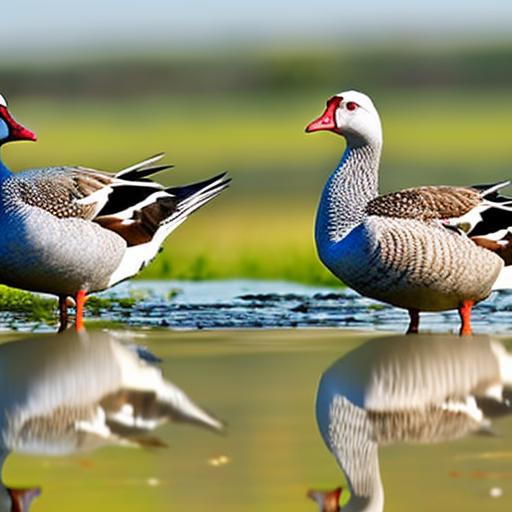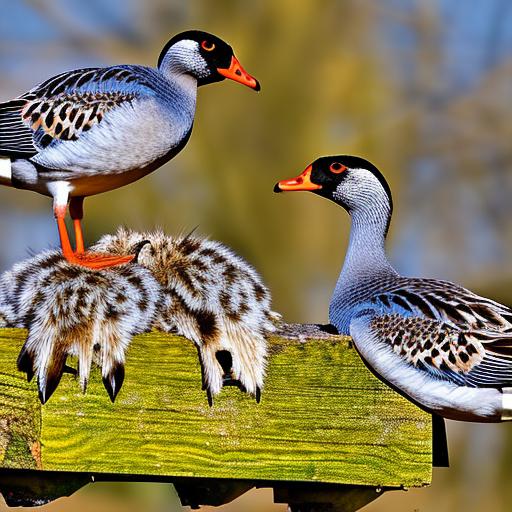Geese have been raised for meat production for centuries, and there are several different breeds that are commonly used for this purpose. Understanding the different geese breeds is important for anyone looking to start a geese meat production business. Some of the most popular geese breeds for meat production include the Embden, Toulouse, and Pekin geese. Each of these breeds has its own unique characteristics and qualities that make them well-suited for meat production. For example, the Embden goose is known for its large size and white feathers, while the Toulouse goose is prized for its flavorful meat and high meat-to-bone ratio. The Pekin goose, on the other hand, is known for its fast growth rate and high feed conversion efficiency. By understanding the different geese breeds and their specific traits, farmers can make informed decisions about which breed is best suited to their meat production goals.
In addition to the specific breed characteristics, it’s also important to consider the overall health and vigor of the geese. Healthy geese will be more productive and efficient in converting feed into meat, so it’s important to choose breeds that are known for their hardiness and disease resistance. Additionally, some geese breeds may have specific dietary requirements or environmental needs that should be taken into account when selecting a breed for meat production. By understanding the different geese breeds and their specific traits, farmers can make informed decisions about which breed is best suited to their meat production goals.
Factors to Consider When Choosing a Geese Breed for Meat Production
When choosing a geese breed for meat production, there are several important factors to consider. One of the most important factors to consider is the size and growth rate of the geese. Larger breeds such as the Embden and Toulouse geese are often preferred for meat production because they can reach a marketable size more quickly than smaller breeds. Additionally, larger breeds typically have a higher meat-to-bone ratio, which can make them more profitable for meat production. Another important factor to consider is the feed conversion efficiency of the geese breed. Some breeds, such as the Pekin goose, are known for their fast growth rate and efficient feed conversion, making them a popular choice for meat production.
In addition to size and growth rate, it’s also important to consider the temperament and behavior of the geese breed. Some breeds may be more docile and easy to handle, while others may be more aggressive or flighty. This can have an impact on the ease of raising and managing the geese, as well as the overall stress levels of the birds. Finally, it’s important to consider the climate and environmental conditions in which the geese will be raised. Some breeds may be better suited to cold or hot climates, while others may have specific environmental requirements that need to be met in order to thrive. By considering these factors when choosing a geese breed for meat production, farmers can make informed decisions that will ultimately lead to a more successful and profitable meat production business.
Popular Geese Breeds for Meat Production and Their Characteristics
There are several popular geese breeds that are commonly used for meat production, each with its own unique characteristics and qualities. The Embden goose is one of the most popular breeds for meat production, known for its large size and white feathers. These geese are prized for their fast growth rate and high meat-to-bone ratio, making them a profitable choice for meat production. The Toulouse goose is another popular breed for meat production, known for its flavorful meat and high feed conversion efficiency. These geese are also known for their calm temperament and ease of handling, making them a popular choice for farmers looking to raise geese for meat production.
The Pekin goose is another popular choice for meat production, known for its fast growth rate and efficient feed conversion. These geese are prized for their large size and high meat-to-bone ratio, making them a profitable choice for meat production. Additionally, Pekin geese are known for their hardiness and disease resistance, making them a popular choice for farmers looking to raise geese for meat production in a variety of environmental conditions. By understanding the specific characteristics and qualities of each breed, farmers can make informed decisions about which breed is best suited to their meat production goals.
Evaluating the Climate and Environment for Geese Meat Production
When it comes to raising geese for meat production, evaluating the climate and environment in which the geese will be raised is crucial. Different geese breeds may have specific environmental requirements that need to be met in order to thrive and reach their full potential as meat producers. For example, some breeds may be better suited to cold climates, while others may thrive in hot or humid environments. It’s important to consider factors such as temperature, humidity, and access to water when evaluating the climate and environment for geese meat production.
In addition to climate considerations, it’s also important to evaluate the overall environment in which the geese will be raised. Factors such as housing, pasture access, and predator control can all have an impact on the health and productivity of the geese. By evaluating these factors and making any necessary adjustments to the environment, farmers can ensure that their geese are able to thrive and reach their full potential as meat producers.
Selecting the Right Geese Breed Based on Farming Goals and Resources
When it comes to selecting the right geese breed for meat production, it’s important to consider farming goals and available resources. Different geese breeds may be better suited to different farming goals, such as producing a certain quantity or quality of meat. Additionally, some breeds may have specific dietary or environmental requirements that need to be taken into account when considering available resources such as feed or housing options.
It’s also important to consider available resources such as land, labor, and financial capital when selecting a geese breed for meat production. Some breeds may require more space or labor than others, while some may have higher initial costs associated with purchasing breeding stock or specialized housing. By carefully considering farming goals and available resources, farmers can make informed decisions about which geese breed is best suited to their specific situation.
Tips for Raising Geese for Meat Production
Raising geese for meat production can be a rewarding endeavor, but it’s important to keep a few key tips in mind in order to ensure success. One important tip is to provide ample space and access to pasture for the geese. Geese are natural grazers and will thrive when given access to fresh grass and other vegetation. Additionally, providing access to water is crucial for raising healthy and productive geese.
Another important tip is to provide a balanced diet that meets the nutritional needs of the geese breed being raised. Different breeds may have specific dietary requirements that need to be taken into account when formulating a feeding program. Additionally, it’s important to monitor the health and well-being of the geese on a regular basis in order to catch any potential issues early on.
Finally, it’s important to handle the geese with care and respect in order to minimize stress and ensure their overall well-being. By following these tips and providing proper care and management, farmers can raise healthy and productive geese for meat production.
Making the Best Choice for Your Geese Meat Production Business
In conclusion, there are several important factors to consider when choosing a geese breed for meat production. By understanding the different geese breeds and their specific characteristics, farmers can make informed decisions about which breed is best suited to their meat production goals. Factors such as size, growth rate, temperament, climate, and available resources should all be taken into account when selecting a geese breed for meat production.
Additionally, it’s important to provide proper care and management in order to raise healthy and productive geese for meat production. By following these tips and making informed decisions about breed selection, farmers can ensure that their geese meat production business is successful and profitable in the long run. With careful consideration and proper care, raising geese for meat production can be a rewarding endeavor that provides high-quality meat products for consumers around the world.
Meet Walter, the feathered-friend fanatic of Florida! Nestled in the sunshine state, Walter struts through life with his feathered companions, clucking his way to happiness. With a coop that’s fancier than a five-star hotel, he’s the Don Juan of the chicken world. When he’s not teaching his hens to do the cha-cha, you’ll find him in a heated debate with his prized rooster, Sir Clucks-a-Lot. Walter’s poultry passion is no yolk; he’s the sunny-side-up guy you never knew you needed in your flock of friends!







